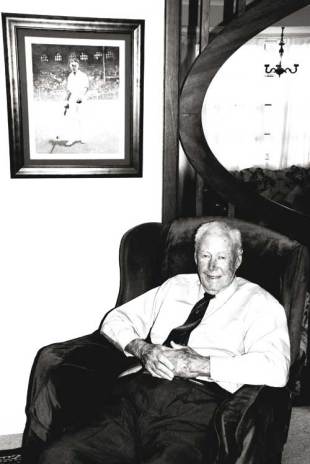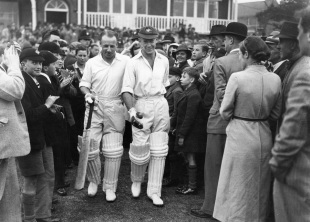
|

"My wife said you could always tell when I was batting by the number of people leaving the ground"
© Cricinfo Ltd
|
|
Bill Brown waited behind the flyscreen front door of his neat house to hand out a welcome. Given his status as an Invincible, it felt necessary to call him Mr Brown. He was a batsman who shielded Don Bradman from the new ball and also left Test cricket on the 1948 tour. Despite his status and tie-on-Sunday attire, he quickly became Bill.
Bill and his wife Barbara are Australian cricket's grandparents: full of wonderful stories about glory days delivered like Christmas presents, semi-regular visitors to their descendants in past or present teams - Barbara Brown chuckled when remembering Glenn McGrath and Steve Waugh bending down to give her hugs - and in a hurry to offer a biscuit and cup of tea before sitting for a chat.
Two hours after unlocking the door Brown led a tour of the remarkable memorabilia in his north Brisbane home, gave advice to a newly engaged couple and offered a lunch-time beer. It was almost four years ago but feels like last week. Worn folders held hundreds of match and tour clippings kept dutifully by the family, and there were green caps, autographs and trinkets from his many travels. He moved on to the signed team photo of the 1934 England tour, won 2-1 by Australia: "There's Bradman, there's me," he said as he pointed. "McCabe, he's dead, O'Reilly, he's dead, he's dead, he's dead ..." Longevity is one of many reasons why Australians treasure Brown: at 95, he is the country's oldest Test living Test player, and its only breathing pre-World War Two cricket representative. There is silence whenever he speaks about invincibility, batting with Bradman and a double-century at Lord's.
Modest to the extreme, he prefers lengthy praise of his team-mates and has spent decades of retirement poking fun at himself with witty one-liners. "My wife said you could always tell when I was batting by the number of people leaving the ground," he said. Brown would swing his bat in the dressing room to ensure perfect position at delivery. The same principle applies in conversation. His public speaking is so lively and entertaining that at Lord's in 1993, MCC officials sat him next to Princess Anne.
Shorter than Damien Martyn and Michael Clarke at 5'7", Brown was a stubborn yet serene right-handed batsman, playing his first Test on the 1934 tour
at Trent Bridge as a 21-year-old. Listed at No. 3, he came in behind the Bills, Woodfull and Ponsford, and in front of the Don. His textbook strokeplay replaced Ponsford's in the next match
at Lord's and his 105 earned a first embossing on the dressing-room honour board.
The Golden Age may have passed but this side was surrounded by gilt edges. Stan McCabe followed Bradman, Bill O'Reilly and Clarrie Grimmett carried the bowling, Brown sparkled intermittently. As support for the superstars, he bordered on the A list
in 22 Tests over 14 years. With 1592 runs at 46.82 his average is higher than those of Mark Taylor, Justin Langer and Clarke.
While Ponsford and Woodfull were the opening pillars of the 1920s and early 1930s, Brown preferred to set out with Jack Fingleton, and they averaged 63.75 runs an innings in ten Tests, the highest of any Australia pair with more than 1000 in partnerships. It is essential to open Brown's records to discover the information obscured by Bradman's heroics and McCabe's hundreds.
Brown's stories are funny, accurate, but historically unfair. The rules of his generation were followed precisely in an era when a leg glance comparable to Archie Jackson's was appreciated alongside art deco. Brown was capable of fine hooks and cover-drives, but the day's constraints often considered them an extravagance. "Our job as openers was made pretty clear: stay there until lunch-time on the first day," he said. "The pace you scored at didn't matter a darn." At least not to the team.

|

Walking out to bat with the Don in 1948: 'For us, who were the rank and file, we ran for him, but you could never keep up with him'
© The Cricketer International
|
|
Flames broke out on a bored SCG Hill one day while Brown was deadening the bowling. The fire brigade and police arrived in a hurry to clean things up and were reprimanded by Yabba, the resident larrikin. "Don't take them away," he shouted, "take away 'Browny'." The same spectators would hassle Brown after lunch if Bradman was still stuck in the dressing room. "Oh," he says, "the crowd used to give me a hurry up."
Batting with Bradman for the first time, in a New South Wales home match at the SCG, Brown was quickly summoned for a chat. "Wow, a mid-wicket conference with the great man," he thought. "You don't run to a request like that, so I tapped the wicket and wandered down like I'd been doing it all my life." Bradman was polite and efficient as he asked Brown if he would please call before he ran. "I never forgot that. Talk about the ground swallowing you up. The next time I called, I like to say you could hear it in the Blue Mountains."
Dusty books never produce the shaking hands and goosebumps that tales from a player who was there provide. Brown was involved in some amazing performances: McCabe's 232
at Trent Bridge, 189 not out
at Cape Town and
187 not out against Douglas Jardine's Bodyline, which Brown saw as a spectator. Then there was Bradman's
304 and
173 not out at Headingley, and his series-rescuing 270
at Melbourne. And Len Hutton's world-record 364
at The Oval.
Brown also captained Australia in their first post-War Test, against New Zealand in 1945-46, leading Ray Lindwall and Keith Miller, and was directly responsible for the naming of the
Mankad run-out. Twice in 1947-48 he was dismissed by Vinoo Mankad, the India left-arm bowler, for backing up too far, a method Brown used throughout his career to prepare for quick singles.
Wrapped in a floral lounge chair and story-telling at his own pace, Brown's limp white hair and sun-spotted complexion enhanced his credibility. His voice was strong and could have been in its 60s; his mind was remarkably free of haze and alert for a compliment. Feeling like a break from cricket, he discussed his beach house before returning to Bradman, a subject he was almost as familiar with as the sports shop he ran in Brisbane when he stopped playing.
"You couldn't keep up with Bradman," he said. "For us, who were the rank and file, we ran for him, but you could never keep up with him. He'd be hitting balls for fours that we'd be fighting to play at."
Having seen so many of Bradman's "wonderful knocks", Brown's favourite Don dig was surprising: 102 not out in the second innings
at Lord's in 1938. "The wicket was wet, England had at least two fast bowlers and the ball was jumping," Brown remembered. "I was up the other end trying to fend off the ball and getting hit. He hooked everything. I've seem him play innings with more fours and all that, but in the conditions that was one of his best."
It is typical of Brown that he failed to mention his significant part in the match, the first televised Test, where the signal was boomed to 17,000 screens. Carrying his bat for 206 in Australia's opening innings, he followed Walter Hammond's 240. "[He] did not cause smoke to rise from the back of those sets but the charm of his style gave viewers a favourable impression of Australian batsmanship," Ray Robinson wrote in On Top Down Under.
In The Bradman Albums Bradman said when Brown reached 200 "he was still batting in a manner of one who might well have stayed in to all eternity". "He stuck manfully to his work and had periods of great brilliance." When pressed, Brown admitted it was a flatter wicket in the first innings, and his display was "vastly different" to McCabe's double in the previous Test.
Barbara returned from reading an Indian cricket magazine and prodded her husband to give more information, but he remained as protective as he did of his wicket. "I took one of my grandsons up to see the honour board when I went back to Lord's," he said. "That was nice." It was Brown at his most revealing, and it was charming.
McCabe was the only batsman Brown reckoned could outpace Bradman. As he reflected on McCabe, his former New South Wales team-mate, he became an excited young boy. The 232 at Trent Bridge, where Australia scored 411 and Chuck Fleetwood-Smith made 5 in a 10th wicket stand of 76, remains so vivid that it could have been or 1997 or 2001. Again, he did not mention his century in the second innings.

|

Legends in the fall: Brown (far left) with Johnston, Harvey and Loxton at a reunion in 2005
© Getty Images
|
|
"Stan played the most magnificent knock I've ever seen," Brown said. "Don Bradman went up to him when he eventually got out and said: 'Stan, if I could play an innings like that, I'd be a very proud man.' It was magic. He was a different style altogether to the Don. He sort of attacked the bowling in a cavalier, easy fashion."
Ten years later Brown embarked on his third six-week voyage to England, to bat in the middle order, play his final two Tests and become an Invincible. "We didn't start off with any particular thought of going undefeated, but it evolved in Don's mind when we started to win matches," he said. Brown believes the "Invincibles" term was an invention of the media, who still rest a lot on the name. The phone rang and he suspected it was a "radio man". "Whenever they want something about WG Grace they give me a ring," he laughed.
Brown's career began in teams that lifted Australia out of the Depression and ended in a squad that helped two nations recover from war. The year 1948 is celebrated in Australia like 1966 and 2003 in England. "Whether or not I'm worth being an Invincible, I'm blessed if I know," he said. "It's very flattering to be a member, even though I didn't do much in the Tests."
Following the death of Miller in 2004 and Bill Johnston in 2007, Brown is one of five survivors from the iconic tour. Back then he chatted regularly to Arthur Morris and Sam Loxton, while Johnston, Neil Harvey and Ron Hamence were always being invited to functions. The modern players' respect for Australia's cricket history grew under Waugh, and Brown was asked to present Test caps to Adam Gilchrist and Scott Muller on their debuts in 1999. Six years later he was back on the field at the Gabba to take part in Michael Hussey's ceremony.
Brown enjoyed watching the modern Australians bat and admired the power of Langer and Matthew Hayden. "Fingleton and I tipped the ball and ran; they hit the ball," he said. He wished he could visit the Gabba more often.
When he does attend, there is star-spotting excitement. As an escort guided Bill and Barbara to The Cricketers' Club during the first Test against New Zealand in 2004-05, they were regularly interrupted by admirers wanting to shake hands. A man wearing a straw XXXX sombrero asked his mate why this old guy was getting such special treatment. He quickly understood the three-word reply. "He's an Invincible."
Peter English is the Australasia editor of Cricinfo


